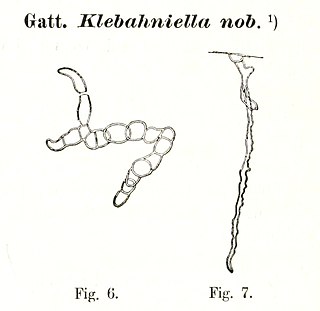Lambia is a genus of green algae in the family Bryopsidaceae.
Leslie Pedley was an Australian botanist who specialised in the genus Acacia. He is notable for bringing into use the generic name Racosperma, creating a split in the genus, which required some 900 Australian species to be renamed, because the type species of Acacia, Acacia nilotica, now Vachellia nilotica, had a different lineage from the Australian wattles. However, the International Botanical Congress (IBC), held in Melbourne in 2011, ratified its earlier decision to retain the name Acacia for the Australian species, but to rename the African species.

Klebahniella is a genus of green algae in the family Chaetophoraceae.
Setchellanthus caeruleus is a species of pungent shrub with large blue flowers. It is placed alone in the genus Setchellanthus, which is in turn, is placed alone in the family Setchellanthaceae. It is endemic to Mexico.
Grovesia is a genus of fungi in the family Helotiaceae. This is a monotypic genus, containing the single species Grovesia pulchella.
Zimmermanniella is a genus of fungi in the family Phyllachoraceae. This is a monotypic genus, containing the single species Zimmermanniella trisporaHenn.
Follmanniella is a genus of lichenized fungi in the family Roccellaceae. A monotypic genus, it contains the single species Follmanniella scutellata.
Simonyella is a genus of lichenized fungi in the family Roccellaceae. A monotypic genus, it contains the single species Simonyella variegataJ. Steiner (1902).
Streimannia is a genus of lichenized fungi in the family Roccellaceae. A monotypic genus, it contains the single species Streimannia varieseptata. The genus was circumscribed by Göran Thor in Opera Bot. vol.103 on page 84 in 1990.
Molleriella is a genus of fungi in the family Elsinoaceae.
Servitia is a genus of fungi in the family Verrucariaceae. A monotypic genus, it contains the single species Servitia inconspicuum(Lynge) M.S. Christ. & Alstrup. It was circumscribed in Alstrup & Hansen, Graphis Scripta vol.12 (2) on page 41 in 2001.
Hassea is a genus of fungi in the class Dothideomycetes. The relationship of this taxon to other taxa within the class is unknown. A monotypic genus, it contains the single species Hassea bacillosa.
Massariola is a genus of fungi in the class Dothideomycetes. The relationship of this taxon to other taxa within the class is unknown. The genus was first described by German lichenologist Wilhelm Füisting in 1868.
Decaisnella is a genus of fungi in the family Massariaceae.
Lahmia is a genus of fungi in the phylum Ascomycota, or sac fungi. It is the only genus in the family Lahmiaceae and the order Lahmiales.
Duboscquella is a genus of dinoflagellates.
Koerberiella is a genus of lichenized fungi within the Lecideaceae family.
Poeltidea is a genus of lichenized fungi within the family Lecideaceae. It contains two species: Poeltidea perusta and Poeltidea inspersa.
Poeltinula is a genus of lichenized fungi in the family Rhizocarpaceae.
Philipp Wilhelm Albrecht Zimmermann was a German botanist. He was a Professor of Botany at several different Universities . He was a botanist and collector of fungi and spermatophytes, who worked in Indonesia and Tanzania from 1902 to 1919. He moved to Indonesia in 1896 and studied applied botany. In 1902 he moved to Africa to join the Amani Research Institute that was established that year. He returned to Germany after World War I in 1920. He wrote about the cultivation of coffee among other things related to botany, but most of his writings were destroyed during World War II.
